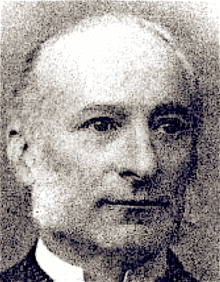
John Macvicar Anderson was born in Glasgow, Scotland on 11 July 1835. After studying at Glasgow University, he was articled to William Clarke (1809-1889) and George Bell (1814-1887) of Clarke & Bell in Glasgow from c.1851, and to his uncle, William Burn, (1789-1870) in London from c.1856. In c.1868 he joined William Burn in partnership as Burn & Anderson. The partnership ended following the death of Burn on 15 February 1870. Anderson then practised alone until 1905 when he formed a partnership with his son, Henry Lennox Anderson (1875-1950).
J.M. Macvicar was Honorary Architect to the Royal Scottish Hospital and the Royal Caledonium Asylum. He was elected an Associate of the Royal Institute of British Architects (ARIBA) in 1864, a Fellow of the Royal Institute of British Architects (FRIBA) in 1868, and President of the Royal Institute of British Architects (PRIBA) from 1891 to 1894.
Anderson's Address was given as 15, Great James Street, Bedford Row, London in 1856; 2 Norfolk Crescent, London in 1864 and 1870; and, from 1870, 6 Stratton Street Piccadilly, London where he died on 9 June 1915
Notable buildings by Anderson included alterations and additions to Orwell Park in Ipswich, Suffolk (1851-53); the Sailor's Home in Bombay [now Mumbai], India (1869); remodelling of Sundridge Park in Bromley, Kent (1878); additions to the Carlton Club, London (1885); the Commercial Bank on Lombard Street and Birchin Lane, London (1888); alterations to Alloway Parish Church in Alloway, Ayrshire (1889); alterations to and enlargement of Inverlochy Castle in Torlundy, Inverness-shire (1889-92); Commercial Union Assurance Building in London (1896); Ashurstwood House, Forest Row, Sussex (1900); additions to Croxteth Hall, Liverpool (1902-04); National Bank of Scotland, London Branch (1902-07); St. Columba's Church of Scotland on Pont Street, London (1904); and Liverpool and London Globe Insurance Co., corner of Cornhill and Lombard Street, London (1904).
_____
Consist of noblemen's and gentlemen's residences In England and Scotland, and banks and Insurance offices In London and elsewhere; among others being — Althorp, Hants; Blankney Hall and Brampton Hall, Lincs: Cheswardine Hall, Shropshire; Iden Manor and Wildernesse, Kent; Powerscourt, Ireland; Coutts's Bank in the Strand; British Linen Co.'s Bank. Threadneedle Street; Liverpool and London and Globe Building. Cornhill; Commercial Union Assurance Co.'s premises, Cornhill; Junior Carlton Club, Pall Mall; and alterations to Brooks's Club, St. James's Street, and many other London clubs. [Source: Who's Who in Architecture 1914]
_____
See also:
British Listed Buildings - 18 listed buildings by John Macvicar Anderson [link below]
Historic England - 19 buildings designed or modified by John Macvicar Anderson [link below]
Directory of British Architects 1834-1914. Compiled by Antonia Brodie, et al. Volume 1: A-K. London; New York: British Architectural Library, Royal Institute of British Architects/Continuum, 2001
Gray, A. Stuart. Edwardian architecture: a biographical dictionary. London: Gerald Duckworth & Co., Ltd., 1985
‘Obituary’. Architectural Review vol. 38, July 1915 p. 22
‘Obituary’. The Builder vol. 108, 18 June 1915 p. 564
‘Obituary’. Royal Institute of British Architects Journal vol. 22, 1915 pp. 403, 416-417, 427
Who's Who in Arechitecture 1914. London: Technical Journals Ltd., 1914